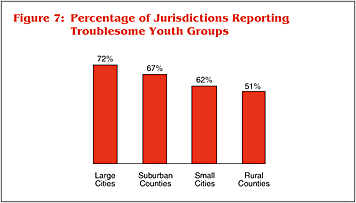|
"Unsupervised peer groups" (Sampson and Groves, 1989) are small groups of adolescents, typically with three or four members, that are highly transitory and poorly organized (Warr, 1996). Many of these groups are involved in occasional delinquent behavior, but they are not committed to a criminal orientation (Short, 1996). As a result, they may be considered troublesome but not threatening to society. These adolescent groups lack size, formal organization, and permanence, and their delinquency typically is not as frequent, serious, or violent as that of youth gangs.
Some researchers have suggested that law enforcement agencies typically do not make a distinction between gangs and unsupervised and troublesome youth groups. To test this notion, survey recipients were asked about these respective groups in their jurisdictions. The data indicated that agencies do recognize the differences between gangs and unsupervised and troublesome youth groups (see figure 7). Approximately 72 percent of large cities reported having unsupervised and troublesome youth groups, followed by 67 percent for suburban counties, 62 percent for small cities, and 51 percent for rural counties.
|
